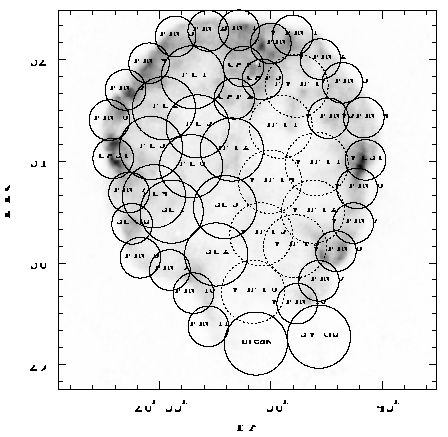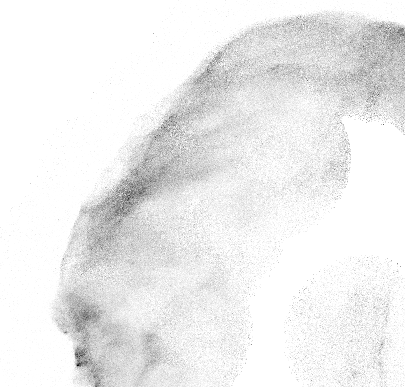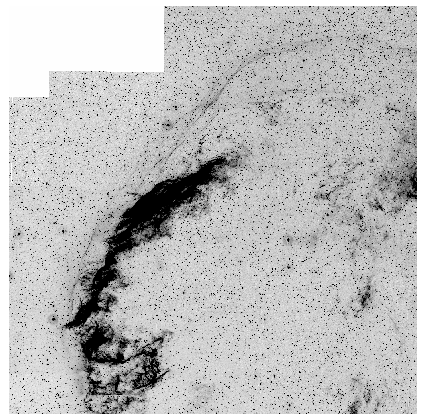THE ROSAT-HRI HIGH RESOLUTION CYGNUS LOOP MOSAIC
James R. Graham & Bernd Aschenbach
Astronomy Department, University of California,
Berkeley, CA 94720, jrg@astro.berkeley.edu
Max-Planck-Institute für Extraterrestrische
Physik, Garching bei München, Germany,
bra@rosat.mpe-garching.mpg.de
Abstract:
We have almost completed a joint US/German campaign to map the entire Cygnus Loop supernova remnant at the maximum practical spatial resolution permitted by the ROSAT-HRI. Substantial progress was made in AO-5 and AO-6, and we hope to complete the remaining 30% of this unbiased survey during AO-7. The Cygnus Loop is the prototype for an ISM-interaction dominated SNR, and as such, provides basic physical information on one of the fundamental mechanisms which shapes the interstellar medium.
We chose the Cygnus Loop because it offers a unique opportunity to learn the details of the interaction of a blastwave with interstellar clouds. We have been rewarded by an unprecedented view of the gas dynamic processes that occur when a blastwave strikes a cloud. The global view afforded by the ROSAT-HRI mosaic highlights the inhomogeneity of the ISM and the pivotal nature of blastwave-cloud interactions in determining the X-ray morphology of the Cygnus Loop. A combination of the ROSAT-HRI survey and a deep H mosaic provides definitive evidence that the Cygnus Loop was formed by an explosion within a preexisting cavity. A by-product of this study is an inventory of the interstellar medium in the vicinity of the Cygnus Loop.
Finally, this survey provides a unique asset for planning observations which make full use of the very high spatial resolution of AXAF.
Introduction
Supernova explosions are a basic process that define the structure of the ISM. The interaction between supernova remnants (SNR) and the interstellar medium (ISM) is complex and symbiotic. Unlike other well-known SNR's, e.g., Cas A, Tycho, or Kepler, the structure of the Cygnus Loop is dominated by its interaction with the ISM. The Cygnus Loop is the prime candidate for a case study of a SNR interacting with a multiphase medium; it is close and has a low foreground column ensuring unrivaled signal-to-noise and spatial resolution. From an observational perspective the Cygnus Loop is unique in terms of X-ray brightness, shock front resolution ( cm), and interaction with a range of ISM environments. The large diameter of the Cygnus Loop ( pc) assures that it is interacting with different components of the ISM: from molecular gas on the NW edge (Scoville et al. 1977), to diffuse atomic gas along the NE and eastern limbs (DeNoyer 1975; Hester et al. 1994), and low density, hot, ionized gas to the south (Ku et al. 1984).
High resolution X-ray observations are crucial for studying SNR gas dynamics because: 1) shock codes predict fully developed turbulence when the blastwave collides with a cloud (Klein 1996); 2) the length scale, , for cooling and recombination is small: cm, where is the preshock number density, and is the shock velocity in units of 100 km s (McKee 1987); 3) clouds sizes and substructure range from scales of tens of pc and downward. Consequently, the improved ROSAT-HRI sensitivity and spatial resolution compared to Einstein make it invaluable for exploring cloud-blastwave interactions. The ROSAT-HRI combines high 0.1-2 keV sensitivity ( better than the Einstein HRI [Zombeck et al. 1990]) and high resolution ( on axis [ROSAT Status Report #85]).
Observational Strategy
Our goal is to map the entire remnant at the highest attainable spatial resolution that can be attained with the ROSAT-HRI. Achieving this ambition is not simple, because the resolution is limited by the intrinsic instrumental properties and photon counting statistics. The large range of surface brightness allows us the luxury of mapping the brightest regions at full HRI resolution, but forces us to seek a compromise between effective resolution and observing time in the dimmest regions. To give a concrete example, the surface brightness observed with the ROSAT yields a count rate in a pixel (essentially an HRI resolution element) of . For the brightest regions along the shell (within of the highest surface brightness) a exposure will net 15 counts (vs. 0.4 background counts). It would take to obtain a similar number of counts in the interior. We therefore adopted the following observing strategy:
- For the brightest regions, the shell and a few selected adjacent regions (mainly the ``carrot'') we can use the full 5'' resolution. This restricts the effective field of view to 8' radius. There are 24 such pointings, each requiring 15-20 ks to obtain 10-15 counts per cell.
- For moderate surface brightness interior regions (e.g., the northeast quadrant) it is possible in a comparable exposure time to obtain typically 10 counts per pixel. For this pixel size, the effective HRI field of view has a 12' radius. There are 9 such fields, each requiring 20-25 ks.
- For the low surface brightness interior regions, we can obtain 10 counts per cell only if we use a 15'' or larger size. For these, we utilize the full HRI field of view. Each of the 10 fields requires a 35 ks exposure.
- One low surface brightness region along the western edge of
the ``breakout'' requires 50 ks.

Figure 1 Scheduled and requested Cygnus Loop ROSAT-HRI pointings
superimposed on the Einstein IPC image (Seward 1990).
Circle size indicates the useful field of view
and is proportional to integration time. Solid
circled fields have been observed or scheduled;
dashed circles are the AO-7 request.
This project is a collaborative project between U.S. and German observers because of the large total observing time required to complete this program ( s). As a joint project, it displays the level of bipartisan collaboration that has been the hallmark of the ROSAT program since its inception, and in this spirit we have divided the Cygnus Loop fields equally among the two national TAC's. It is our intention to carry out this program for the community at large, therefore we have waived our proprietary rights so as to grant immediate access to the data.
Progress Report
The data were reduced using Snowden's software for extended objects and X-ray background analysis (cf. Snowden et al. 1994). For each observation, using only the accepted time intervals listed in the raw data files, three images are created. The first contains the total counts, the second is a model of particle background, and the third is an exposure map, which includes the variations in the detector quantum efficiency. These images have 5'' pixels, matching the detector resolution. These maps from individual fields are summed on a pixel-by-pixel basis into three mosaics of the entire Cygnus Loop field with 15'' pixels. Over such large spatial scales each observation is a distinct projection of the sky onto the plane of the detector, and these must be remapped to a common projection. Only the central 17' of each observation is used in order to avoid the significant degradation of the point spread function and decreased efficiency at large off-axis angles. The count-rate map is the difference of the total counts and the total background, divided by the net exposure. Background subtraction is not a problem for the bright and moderately bright fields. The background does become comparable with the source surface brightness for the lower surface brightness regions. However, we have little difficulty extracting low surface brightness features because of the temporal and spatial stability of the HRI background, and our ability to cross register fields containing predominantly weak emission with adjacent ones containing bright features. To display the high resolution information contained in the mosaic we also show a zoom field which has been binned with 6'' pixels. (Figure 3)

Figure 2 The current status of the Cygnus Loop ROSAT-HRI
mosaic. A total of 391,087 s from 31 pointings of the
ROSAT-HRI in 24 positions are combined into this map
and binned in 15'' pixels.
At first sight the X-ray morphology depicted in the ROSAT-HRI mosaic
presents a bewilderingly complex view. The clearest message is that the
Cygnus Loop is not an adiabatic blastwave propagating in a uniform
medium and cannot be approximated as a Sedov remnant. There is
considerable large and small scale azimuthal variation around the
perimeter of the Loop and significant structure projected across its
face. The X-ray emission is dominated by two prominent areas: one to
the west and another to the east/northeast. Each region consists of a
complex network of filaments and high surface brightness clumps. The
emission is predominantly limb brightened, but the contrast is much
greater than for an adiabatic blastwave. Significant emission (e.g.
the eastern limb) lies well within the projected edge of the blastwave

Figure 3: The NE rim of the Cygnus Loop
from the ROSAT-HRI mosaic. The data have been
binned in 6'' pixels. The field of view is 1.5 deg.

Figur4: The NE rim of the Cygnus Loop in H.
The field has been registered with the X-ray field
shown in Figure 3.
- closer to the center than expected for an adiabatic blastwave.
The correlation between X-ray and optical line-emission falls into three broad categories that are distinguished by surface brightness and morphology: 1) regions of high surface brightness X-ray emission distributed in long coherent arcs which are aligned tangentially with, and lie interior to, the bright optical filaments, e.g., NE (NGC 6992, Figures 3 , 4);2 indentations in the shell where bright X-ray emission occurs at large distances behind the projected edge of the blastwave, e.g., the eastern edge, the SE cloud, and the bright funnel shaped section at the N. These regions tend to be more chaotic and include the most compact and highest surface brightness regions within the Loop; 3) regions of low surface brightness limb-brightened X-rays bounded on the outside by faint, thin Balmer-line filaments, e.g., extreme N in Figures 3 & 4). Type (3) filaments trace the projected edge of the blastwave since Balmer-line filaments occur where previously undisturbed atomic gas is shocked (Hester, Danielson, & Raymond 1986).
Category (1) and (2) occur where the shock has encountered a greater than average column of gas, which has caused substantial deceleration of the blastwave (Hester & Cox 1986, Hester, Raymond, & Blair 1994, Graham et al. 1995, Levenson et al. 1996). The difference between regions (1) and (2) may be due to viewing geometry, the shape of the cloud which is being encountered, and the time since enhanced density was encountered by the shock. For example, the morphology of the western edge can be interpreted because this region is viewed almost exactly edge on and the complication of projection effects are minimized (Levenson et al.).
It is crucial to decide whether the clouds that have been struck by the blastwave are isolated, or part of a coherent structure, e.g., an H II region cavity or wind blown bubble formed by the SN progenitor. We have argued that the appearance of the eastern edge and the SE cloud can only be explained if it is determined by the shape of a preexisting cavity (Graham et al. 1995). To a large degree the cavity must be spherical because the Cygnus Loop is approximately circular. However, to explain the regions of high optical and X-ray surface brightness there are several locations where the cavity walls protrude into the Cygnus Loop. Columns of gas can protrude into the H II region cavity if they are overdense regions - just like the elephant-trunk structures seen in HST/WFPC-2 images of M 16.
Evidence from filaments in category (3) clinch the argument in favor of a cavity. The new HRI and H data trace the projected edge of the blast wave over an unprecedented 70% of the perimeter of the Loop. Remarkably, the X-ray emission extends right to the edge of the blastwave in every case where it is bounded by Balmer-line filaments. This is contrary to what is expected for either a Sedov or evaporative remnant. The fact that bright X-ray emission extends all the way to the edge of the blastwave suggests that the shock has collided with a density enhancement. The ubiquity of this morphology indicates that the Cygnus Loop is located within a cavity.
Acknowledgments
This project is a collaborative project between U.S. and German scientists. The Cygnus Loop ROSAT-HRI team consists of: B. Aschenbach, W. P. Blair, W. Brinkmann, J. -U. Busser, R. Egger, R. A. Fesen, J. R. Graham, J. J. Hester, S. M. Kahn, R. I. Klein, N. A. Levenson, C. F. McKee, R. Petre, R. Pisarski, J. C. Raymond, & S. Snowden. The mosaics were created by N. A. Levenson as part of her thesis, using S. Snowden's ESAS software. The emission-line images were obtained using the prime focus camera at the 30-inch telescope at McDonald Observatory.
An electronic version of this article can be found at http://astro.berkeley.edu/jrg
References
DeNoyer, L. K. 1975 ApJ 196 479
Graham, J. R., Levenson, N A., Hester, J. J., Raymond, J. C., & Petre, R. 1995 ApJ 444 787
Hester, J. J., Danielson, G. E., & Raymond, J. C. 1986 ApJL 303 L17
Hester, J. J., & Cox, D. P. 1986 ApJ 300 675
Hester, J. J., Raymond, J. C., & Blair, W. P. 1994 ApJ 420 721
Ku, W. H.-M., Kahn, S. M., Pisarski, R. & Long, K. S. 1984 ApJ 278 615
Klein, R. I. 1996 private communication
Klein, R. I., McKee, C. F., & Colella, P. 1994 ApJ 420 213
Levenson, N A., Graham, J. R., Hester, J. J., & Petre, R. 1996 ApJ 469 000
McKee, C. F. 1987 in Spectroscopy of Astrophysical Plasmas, Eds. A. Dalgarno & D. Layzer, Cambridge University Press.
Scoville, N. Z., Irvine, W. M., Wannier, P. G., & Predmore, C. R. 1977 ApJ 216 320
Seward, F. D. 1990 ApJS 73 781
Snowden, S. L., McCammon, D., Burrows, D. N., & Mendenhall, J. A. 1994 ApJ 424 714
Zombeck, M. V., et al. 1990 Proc SPIE 1344 267
Return to the Title Page
About this document ...
This document was generated using the LaTeX2HTML translator Version 96.1 (Feb 5, 1996) Copyright © 1993, 1994, 1995, 1996, Nikos Drakos, Computer Based Learning Unit, University of Leeds.
The command line arguments were:
latex2html -split 0 graham.tex.
The translation was initiated by Michael Arida on Mon Jun 3 15:34:54 EDT 1996
Michael Arida
Mon Jun 3 15:34:54 EDT 1996

